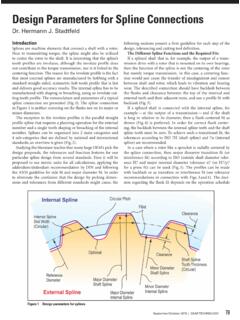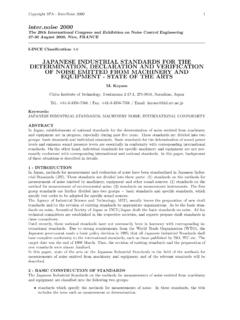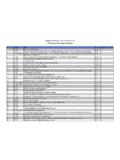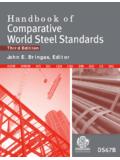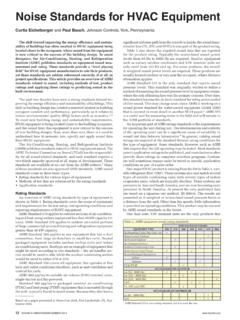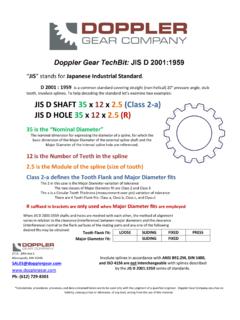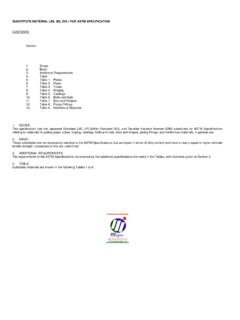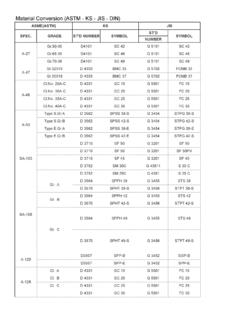Transcription of New ANSI/AGMA Accuracy Standards for Gears
1 22 MARCH/APRIL 2004 GEAR TECHNOLOGY for a ChangeFor many years, the system of gear accu-racy tolerances has been provided by AGMA2000-A88, Gear Classification and InspectionHandbook. This document has been commonlyused for gear Accuracy specifications in contrac-tual agreements for vendor-supplied Gears . Also,it has often been used as the basis of internal com-pany gear tolerance material within AGMA 2000-A88 hasbeen carried forward without substantial changefor nearly 40 years. It is widely considered to beoutdated and in need of comprehensive revision,particularly with respect to the following issues:1.
2 Lead tolerances in 2000-A88 are substantiallylarger than those found in other national gearaccuracy ) The standard lacks tolerances for cumulativepitch ( index) ) The K-shaped tolerance band method provid-ed in 2000-A88 for control of involute profile andhelix ( lead or tooth alignment) deviations isless desirable than line-fit tolerance methodsfound in other national gear Accuracy that the standard was overdue forrevision, the AGMA Inspection HandbookCommittee developed a new suite of replacementdocuments. The first three of these new standardswas published about a year ago.
3 After the remain-ing documents are published in about a year,AGMA2000-A88 will be , it is very important to understandthe coming ISO ConnectionIn recent years, AGMA technical standardsdevelopment has increasingly focused uponachieving harmony with ISO gear Standards . TheAGMA Technical Division Executive Committee(TDEC) now requires technical committees toconsider adoption of relevant ISO Standards ,wherever possible, instead of writing new AGMA documents. Also, it is required that all new stan-dards produced by AGMA committees be in SI(metric) units of changes are seen by the AGMA as animportant element in its increasing emphasis onassuring the competitiveness of the gearindustry in the rapidly evolving world market-place.
4 With make/buy decisions becoming anincreasingly prevalent issue for gear productusers, selection of a genuinely international gearaccuracy standard is increasingly the international makeup of ISO stan-dards writing committees, their documents areviewed as inherently global in nature. The impor-tance of ISO gear Standards is expected toincrease substantially in coming years. An exam-ple of the potential power of ISO Standards can beseen in the widespread adoption of ISO 9000 , existing ISO gear Accuracy stan-dards and technical reports were used as startingtemplates, along with selected material from cur-rent AGMA Standards , in the development of thenew ANSI/AGMA Standards .
5 Also, AGMA hopesthat much of the new material in its new accuracystandards will gain acceptance for inclusion in thenext-generation ISO of MaterialAGMA 2000-A88 combined all of the materi-New ANSI/AGMA AccuracyStandards for GearsEdward LawsonManagement SummaryAGMA has started to replace its 2000-A88 standard for gear accuracywith a new series of documents based largely on ISO Standards . The firstof the replacement AGMA Standards have been published with theremainder coming in about a year. After serving as a default accuracyspecification for commerce in gear products for several decades,the material in AGMA 2000-A88 is now considered outdated and in needof comprehensive changes include reversal of the Accuracy grade system(larger grade numbers now mean larger tolerances), introduction of tol-erances based on ISO 1328, new line-fit methods of analyzing helix(lead)
6 And profile test traces, and the inclusion of single-flank compos-ite testing as an optional alternative method of qualifying descriptions of required measurement methods are providedto reduce ambiguity and the associated potential for these changes is the important transition from relianceupon local Standards , such as AGMA, DIN, JIS, BGA, etc., to internation-al adoption of ISO Standards , which are now positioned to become thedefault specifications for global commerce in gear Layout 3/3/04 1:20 PM Page 22al for measuring and tolerancing Gears in a singledocument.
7 The new AGMA Accuracy standardssegregate the material into four main documents,following the organization of the analogous are divided according to tangential(single-flank) vs. radial (double-flank) considera-tions. Additionally, material is presented in either:1.) a standard limited to definitions, the tolerancesystem, and required related information; or2.) an information sheet containing measuringmethods and other helpful information (referredto as a technical report in ISO).The existing ISO and new AGMA gear accu-racy documents correlate as shown in Figure Status of New StandardsIn late 2002, the new tangential Accuracy stan-dard ANSI/AGMA 2015-1-A01, AccuracyClassification System Tangential Measure-ments for Cylindrical Gears , was published.
8 Itprovides the tolerance system for profile, helix,pitch (single and cumulative), and single-flankcomposite early 2003, the associated tangential accu-racy information sheet AGMA 915-1-A02,Inspection Practices Part 1: CylindricalGears Tangential Measurements, was pub-lished. It provides the required measurementmethods and supplementary mid-2003, an additional document, Supple-mental Tables for AGMA 2015/915-1-A02, Accuracy Classification System TangentialMeasurement Tolerance Tables for CylindricalGears,was published.
9 Since 2015-1 tolerances areprovided in the form of equations, many userswere asking for a set of tables, which are moreconvenient for quick reference. However, it mustbe noted that most tolerance equations are non-lin-ear, so interpolation between table values will notproduce accurate tolerance calculation program forANSI/AGMA 2015-1-A01 has also been pro-duced that provides a quick, easy way to accu-rately determine tolerances for a given gear. It isavailable free in the members-only section of theAGMA Inspection and Handbook Committee iscurrently developing a new standard, ANSI/AGMA 2015-2-AXX, and associatedinformation sheet, AGMA 915-2-AXX, pertain-ing to radial (primarily double-flank composite) Accuracy the radial Accuracy documents are pub-lished, the AGMA intends to withdraw GEAR TECHNOLOGY MARCH/APRIL 2004 232000-A88 as an active standard.
10 It will, however,continue to be available for sale for the foresee-able New Accuracy Grade SystemAGMA 2000-A88 includes 13 quality classesnumbered Q3 through Q15, in order of increasingprecision. ANSI/AGMA 2015-1-A01 provides 10accuracy grades numbered A2 through A11, inorder of decreasing precision. In other words, thesmaller the Accuracy grade number in the newstandard, the smaller the tolerances. While this isthe opposite of the structure of 2000-A88, it fol-lows the convention of all other major gear accu-racy difference inevitably raises questions asto how one can compare tolerance gradesbetween old and new AGMA Standards .
